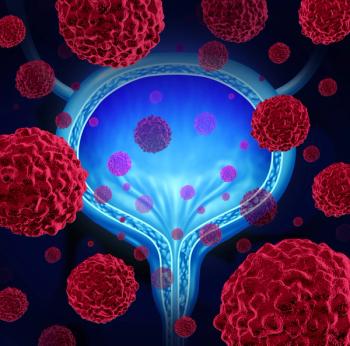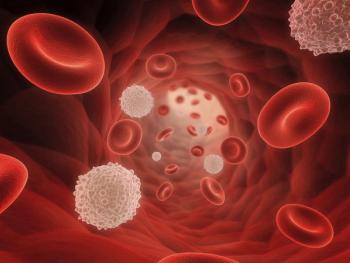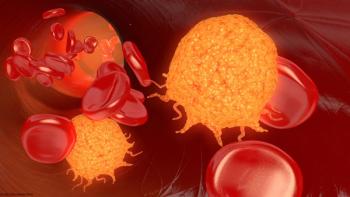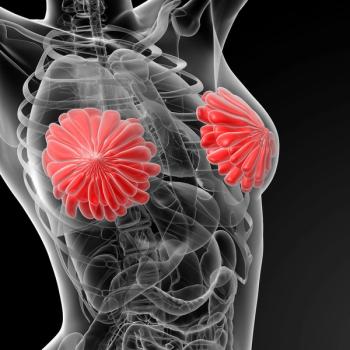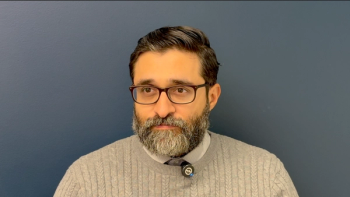
- ONCOLOGY Vol 14 No 10
- Volume 14
- Issue 10
UFT and Its Metabolites Inhibit Cancer-Induced Angiogenesis via a VEGF - Related Pathway
Treatment with UFT for spontaneous lung metastasis of murine renal carcinoma (RENCA) after resection of the primary tumor has resulted in significant prolongation of the life span of tumor-bearing animals. UFT inhibited the growth of metastatic nodules in the lung, apparently via decreased density of microvessels in the metastatic foci. Subsequent experiments used dorsal air sac assay to directly trace newly forming microvessels.
ABSTRACT: Treatment with UFT for spontaneous lung metastasis of murine renal carcinoma (RENCA) after resection of the primary tumor has resulted in significant prolongation of the life span of tumor-bearing animals. UFT inhibited the growth of metastatic nodules in the lung, apparently via decreased density of microvessels in the metastatic foci. Subsequent experiments used dorsal air sac assay to directly trace newly forming microvessels. UFT abrogated the process of angiogenesis, induced by the RENCA cells, in a dose-dependent manner. The inhibitory effect appeared to originate from tegafur, a component of UFT, and from its known metabolites: fluorouracil (5-FU), g-hydroxybutyric acid (GHB), and g-butyrolactone (GBL). The inhibition of angiogenesis by UFT appeared to be a common phenomenon, also observed in other human cancer cell lines characterized by an excessive production of vascular endothelial growth factor (VEGF)-such as gastric, lung, and colon cancers. In vitro analysis revealed that 5-FU and g-hydroxybutyric acid regulated VEGF-dependent responses of human umbilical vein endothelial cells. Dorsal air sac assay revealed that UFT, 5-FU, and g-hydroxybutyric acid strongly inhibited the angiogenesis induced by recombinant human VEGF. These data suggest that the antiangiogenic activity of UFT is at least partially associated with an ability of the metabolites of UFT to interfere with VEGF-dependent responses of vascular endothelial cells. [ONCOLOGY 14(Suppl 9):68-71, 2000]
Fluorinated pyrimidines are agents that have been widely used to treat a variety of cancers. Their continually expanding role in cancer chemotherapy is related to the introduction of new treatment regimens and combinations with other agents, and to the development of oral formulations suitable for prolonged administration. UFT, an anticancer agent composed of tegafur and uracil in a molar ratio of 1:4, is a second-generation, fluorinated pyrimidine-based drug that is widely used in Japan and is now undergoing intensive clinical evaluation in the United States.[1] Oral administration of UFT produces fluorouracil (5-FU) plasma levels similar to those observed in cancer patients after continuous intravenous infusion.
Early clinical reports indicate that UFT inhibits the growth not only of primary tumor but also metastatic sites.[2-4] Several studies[5,6] have demonstrated that UFT prevents or inhibits metastasis in tumor-bearing animals and is closely associated with increased survival. However, the mechanism of inhibition remains unknown. Our recent studies aimed to clarify the antimetastatic effect of UFT and elucidate a possible mechanism involved in this phenomenon.
In the process of cancer metastasis, one of the crucial steps is angiogenesis, the process of delivery of essential energetic factors and oxygen to a newly growing tumor mass.[7-9] The inhibition of the formation of microvessels entering or developing in a tumor affects the expansion of micrometastases and may lead to disappearance of the tumor and, consequently, increased survival. Tumor-celldriven angiogenesis is controlled by vascular endothelial growth factor (VEGF), fibroblast growth factor-2, interleukin-8, and several other growth factors produced by tumor mass.[10-12] It seems reasonable, therefore, to consider their role in the antimetastatic and antiangiogenic activity of a drug, specifically UFT.
In this study, we attempted to (1) demonstrate an inhibitory effect of UFT on spontaneously forming metastasis and its role in increased survival, (2) find a correlation between antitumor (antimetastatic) effect and inhibition of an expanding tumor microvasculature, and (3) identify growth factors affected by UFT and related compounds in angiogenesis.
Spontaneous Metastasis to the Lung in Mice
The murine renal cancer cell line (RENCA) was kindly provided by Dr. I. J. Fidler, University of Texas M. D. Anderson Cancer Center, Houston, Texas. On day 0, RENCA cells 2 ´ 104 were implanted into the left kidney of BALB/cA mice. Ten days later, the primary tumor growing in the kidney was surgically removed. The anticancer effect was evaluated based on prolonged survival of tumor-bearing animals, which were dying of intensive metastasis to the lungs. The survival effect of drug-treated animals was evaluated as the ratio of the mean survival time of treated animals to that of control animals. The density of microvessels in the lung metastatic foci was determined by immunostaining with an antiCD-31 monoclonal antibody.
Dorsal Air Sac Assay in Mice
This experiment was performed exactly as described previously.[13] Briefly, the Millipore chambers containing either tumor cells or recombinant human VEGF (rhVEGF) were implanted into the preformed air sac in the dorsum of a male BALB/cA mouse.
Five days after implantation, the chambers were removed from subcutaneous fascia and the angiogenic response was assessed with dissecting microscope photographs to determine the number of newly formed blood vessels. The extent of angiogenesis was scored as an index of 0, 1, 2, 3, 4, and 5 for the numbers of newly formed blood vessels showing zigzagging characteristics in the area attached to the chamber of 0, 1, 2, 3, 4, and 5 or more.
Life-Prolonging Effects of UFT in Lung Metastasis Model
This study examined the life-prolonging effects of several anticancer drugs, including UFT, 5-FU, and TNP-470, in the lung spontaneous metastasis model of murine RENCA cells. In this metastasis model, there was a 100% incidence of spontaneous metastasis to the lung.
The average survival time for the control animals was 41.3 ± 2.9days (mean ± SEM). The UFT-treated (20 mg/kg/day) animal group showed a significant life-prolonging effect as manifested by a corresponding treated to control response ratio (T/C) value of 160.8% (P < .05). The group of animals treated with 5-FU (13 mg/kg/day) also experienced the life-prolonging effect, although 5-FU was less potent (T/C = 125.7%, P < .01). Conversely, TNP-470, a known antiangiogenic agent, showed only a marginal effect on the survival of treated animals (Figure 1).
In a separate experiment, the antimetastatic effects of test compounds were evaluated 34 days after implantation of cancer cells by determining the total weight of cancer-invaded lungs. The average weight of normal lungs of the age-matched animals was 0.13 g, while cancer-invaded lungs weighed 0.45 g, indicating the presence of intensive metastases. The weights of invaded lungs were significantly reduced with UFT, TNP-470, and, to lesser extent, 5-FU, as demonstrated by corresponding TC values of 44.5%, 51.3%, and 64.9%, respectively (data not shown).
The tumor mass reduction in the lungs of treated animals was associated with a decrease in the number of blood vessels in metastatic nodules, as determined by an immunochemical staining with an antiCD-31 monoclonal antibody. The number of blood vessels in the cancer nodules was reduced by 35.5%, 20.6%, and 61.5% following treatment with UFT, 5-FU, and TNP-470, respectively.
Antiangiogenic Activity of UFT in DAS Assay
The decreased blood vessel density in lung metastatic foci of drug-treated animals indicated a possible inhibition of cancer-induced angiogenesis. Therefore, we examined whether UFT treatment directly affected the angiogenesis, or was an indirect effect resulting from tumor shrinkage. The evaluation of antiangiogenic activity was performed in a dorsal air sac (DAS) assay, in which the process of angiogenesis was induced by RENCA cells in suspension, embedded between semi- permeable membranes. UFT showed a marked inhibition of RENCA cell-induced angiogenesis, exceeding that observed after treatment with 5-FU.
UFT is composed of uracil and tegafur; the latter is further metabolized in vivo to 5-FU and g-hydroxybutyric acid (GHB) (Figure 2).[14,15] Therefore, we looked for an active chemical entity originating from UFT that might be responsible for antiangiogenic activity. We examined the effects of uracil and tegafur as well as the metabolites of tegafur: 5-FU, GHB, and g-butyrolactone (GBL) in a DAS assay.
The angiogenic response induced by RENCA cells was abrogated both by 5-FU and tegafur, while uracil remained completely inactive. Surprisingly, GHB and GBL, which are biotransformation products of tegafur, showed pronounced inhibition of angiogenesis (Figure 3).
To examine whether the antiangiogenic effect of UFT is limited to a particular cell line or is universal, further studies were performed using human cancer cell lines such as gastric, lung, and colon cancers. This experiment revealed a wide spectrum of antiangiogenic activity with UFT: five of five tested cell lines, including RENCA cells, responded to the antiangiogenic activity of UFT and 5-FU.
Effects on VEGF-Dependent Responses in HUVEC
Several cancer cell lines in vitro and in vivo reportedly produce VEGF and fibroblast growth factor-2 (FGF-2), known angiogenesis-promoting factors. In our experiments, we found VEGF to be predominantly produced and secreted by cancer cells, while FGF-2 was present in minimal quantities. We suspected, therefore, that the antiangiogenic activity of UFT might be related to the suppression of VEGF-dependent response of vascular endothelial cells by 5-FU or GHB.
The experimental results on the proliferation of VEGF-stimulated human umbilical vein endothelial cells (HUVECs) revealed concentration-dependent inhibition of HUVEC cell proliferation by 5-FU, while no inhibition was observed in the case of GHB. On the other hand, 5-FU and GHB abrogated chemotactic migration and tube formation of HUVECs stimulated with VEGF (data not shown). These results indicate that UFT suppresses angiogenesis, partly by an antiproliferative effect of 5-FU, a cytotoxic metabolite, and predominantly by the inhibition of the VEGF-dependent responses of vascular endothelial cells mediated by GHB, a completely noncytotoxic metabolite of UFT.
These effects, observed in vitro, were reproduced in the experiment performed in vivo in a DAS assay, when the angiogenesis was induced by rhVEGF (Table 1). The UFT treatment resulted in 94.2% inhibition of VEGF-induced angiogenesis, while the treatment with an equimolar dose of GHB was associated with a complete lack of any angiogenic response. This effect was also seen with 5-FU but was less pronounced.
This study attempted to confirm previously reported cases of the antimetastatic activity of UFT and to demonstrate its implication to the prolongation of the life span of tumor-bearing animals. A significant increase in survival time demonstrates that UFT is a potent drug in the model of murine cancer that spontaneously metastasized to the lungs. Moreover, the metastasis-reducing potential of UFT is accompanied by a decreased number of microvessels in lung metastatic nodules. Also, the inhibition of cancer-induced angiogenesis appears to be closely associated with UFT (shown by a DAS assay allowing us to trace the formation of new blood vessels). It is of great interest that the antiangiogenic effect of UFT is related to tegafur, and especially to its metabolites 5-FU, GBL, and GHB, the latter being noncytotoxic.
The angiogenesis inhibitory effect of UFT is not limited to murine cancer. It was also observed in various human cancer cell lines. In vitro experiments revealed the ability of UFT-derived compounds to inhibit VEGF-mediated vascular endothelial cell proliferation and their chemotactic migration and tube formation. However, inhibition of cell proliferation was only observed with 5-FU, a cytotoxic metabolite of UFT. These data indicate that UFT has an antiangiogenic potential due to its ability to disrupt a VEGF-mediated process controlling the proliferation of vascular endothelial cells.
References:
1. Pazdur R: Beyond 5-fluorouracil. Oncology 13 (suppl):15-16, 1999.
2. Taguchi H, Takaoka K, Matsuda M: A case of renal cell carcinoma with lung metastasis and local recurrence effectively treated with nephrectomy and UFT. Gan To Kagaku Ryoho 19:2395-2398, 1992.
3. Fukuoka H, Takeda M, Nomura S, et al: Complete remission of lung metastases of bladder tumor treated by small dosage of UFT: A case report. Hinyokika Kiyo 37:541-544, 1991.
4. Pazdur R, Lassere Y, Rhodes V, et al: Phase II trial of uracil and tegafur plus oral leucovorin: An effective oral regimen in the treatment of metastatic colorectal carcinoma. J Clin Oncol 12:2296-2300, 1994.
5. Kurebayashi J, Sonoo H: Antiproliferative and antimetastatic effects of UFT on MKL-4 human breast cancer cells transplanted into nude mice. Gan To Kagaku Ryoho 22:665-670, 1995.
6. Matsushita K, Kuramitsu Y, Ohiro Y, et al: Combination therapy of active hexose correlated compound plus UFT significantly reduces the metastasis of rat mammary adenocarcinoma. Anticancer Drugs 9:343-50, 1998.
7. Ausprunk DH, Folkman J: Migration and proliferation of endothelial cells in preformed and newly formed blood vessels during tumor angiogenesis. Microvasc Res 14:53-65, 1977.
8. Weinstat-Saslow D, Steeg PS: Angiogenesis and colonization in the tumor metastatic process: basic and applied advances. FASEB J 8:401-407, 1994.
9. Folkman J: Angiogenesis in cancer, vascular, rheumatoid and other disease. Nat Med 1:27-31, 1995.
10. Kumar R, Yoneda J, Bucana CD, et al: Regulation of distinct steps of angiogenesis by different angiogenic molecules. Int J Oncol 12:749-757, 1998.
11. Cronauer MV, Hittmair A, Eder IE, et al: Basic fibroblast growth factor levels in cancer cells and in sera of patients suffering from proliferative disorders of the prostate. Prostate 31:223-233, 1997.
12. Shibusa T, Shijubo N, Abe S: Tumor angiogenesis and vascular endothelial growth factor expression in stage I lung adenocarcinoma. Clin Cancer Res 4:1483-1487, 1998.
13. Yonekura K, Basaki Y, Chikahisa L, et al: UFT and its metabolites inhibit the angiogenesis induced by murine renal cell carcinoma, as determined by a dorsal air sac assay in mice. Clin Cancer Res 5:2185-2191, 1999.
14. Wu AT, Au JL, Sadee W: Hydroxylated metabolites of R,S-1-(tetrahydro-2-furanyl)-5-fluorouracil in rats and rabbits. Cancer Res 38:210-214, 1978.
15. Au JL, Sadee W: Activation of Ftorafur [R,S-1-(tetrahydro-2-furanyl)-5-fluorouracil] to 5-fluorouracil and gamma-butyrolactone. Cancer Res 40: 2814-2819, 1980.
Articles in this issue
about 25 years ago
New Awards Spotlight Courage of Cancer Survivorsabout 25 years ago
Children’s Art Project at M. D. Anderson Cancer Centerabout 25 years ago
Settling on an Increased NCI Budgetabout 25 years ago
Computer Billing Standardabout 25 years ago
Ligand Receives FDA Marketing Clearance for Bexarotene Gelabout 25 years ago
Mayo Clinic Study Shows Patients Uncertain About Cancer Risk Termsabout 25 years ago
Multidisciplinary Management of Pediatric Soft-Tissue SarcomaNewsletter
Stay up to date on recent advances in the multidisciplinary approach to cancer.


